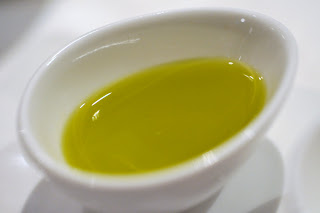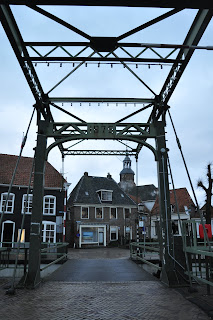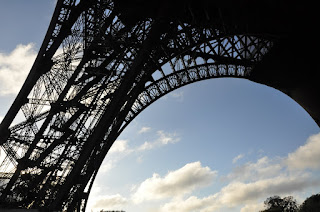We don't have a whole lot of money. Between my student loans and his insurance policies, we're basically living paycheck-to-paycheck, though we each have a healthy savings account and both of us contribute to our joint account. Needless to say, we don't eat out very often—you can count the number of times we get take-out in a year on one hand.

But we do love good food. So every week, we empty our wallets of whatever notes (Christmas money) and spare change (eating out) is left. At the end of the year, or whenever the jar gets too heavy, whichever comes first, we haul the coins to the bank, and get them counted. It adds up: in this case, to a trip to
Kaatje aan de Sluijs, a little restaurant in
Blokzijl, which is a little village in the middle of nowhere. Friends of ours had invited us along to help them celebrate their tenth anniversary, and good food and a luxe hotel for not-too-extravagant prices are not to be passed up. Blokzijl's claim to fame is that it used to be a seaside town, until the
Dutch filled in their corner of the North Sea in the 1930s. Now, it sits behind a dike that was undoubtedly more impressive in the days when it actually held back the sea, but still squarely in the middle of nowhere, with endless polderlands stretching beyond it in all directions.

Nevertheless the village itself is a lovely little place, though hardly exciting by any definition of the word. There's an antique clock shop on the main street, and some nice little pubs, and of course a church (Baptist, interestingly). The little village still has the narrow streets of pre-car days, and there are no curtains in the windows, in keeping with the (now disappearing) Dutch tradition of making sure your neighbors are as virtuous as you are. You can sail on the river that runs through the village, though at this moment you might want to get ice insurance before you do.

At Kaatje aan de Sluis, you have the option of a four-course dinner menu; I assume that the restaurant also has an a la carte menu, but for whatever reason it wasn't available on the day that we went. We were greeted at the door by a grinning, almost bouncy, maitre'd, seated, and almost before we had a chance to get our bearings, a member of the wait staff came along and asked us what we'd like to have for a drink. A few minutes later, the first amuses arrived.

The dishes were served relatively quickly: at the
Chateau Neercanne, for instance, it averaged out to one dish an hour (and yes, we were actually there for almost six hours). It was still 23.00 by the time we left, but it ended up being an almost-seven-course meal, including coffee, a pre-dessert, and lots of wine-snobbery, where the sommelier presents you with a bottle of wine, cradled in a towel (for whites), and gives you the genetic lineage of the grapes that went into it, and pours out a small measure of wine for the wine-master. In our case, that was the wife of our friend, and the wines that the staff had chosen really were very good, with a sweet nose but a complex taste. And that's about the extent of my wine knowledge.
As for the food itself: well, pictures are worth a thousand words, right? Suffice it to say that the words, “Oh my God,” came out of my mouth more than once—and that was just about the olive oil to dip the bread in.

From top to bottom, the dishes are: foie gras , served with carmelized shallots and an orange-flavored cookie; the
snoek (with cauliflower puree and potato square); wild duck served with sarsaparilla root, leek, red beet, and lentils); and dessert, a parfait of oranges, sweet-corn custard, almonds, and dragon-flavored ice cream, served alongside candied popcorn.




After such a gastronomic undertaking, we decided that a little coffee wouldn't be a bad idea. But that was with the assumption that coffee was just coffee. We're relatively new to fine dining, but we're learning: coffee is never “just coffee”.

I'm a vegetarian, which makes things a little awkward when foie gras and wild duck are the only items on the menu. Fortunately, our friends and my boyfriend were ravenous—they'd skipped their meals that day, too—so they were more than happy to relieve me of both of the items. I found myself trying some of them (both the foie gras and the duck) out of propriety, but after not having any meat for several years, the taste of them both were a bit much for me. However, I am assured by the three others at the table that, if you eat meat, you will love it.
The hotel we stayed in was “attached” to the restaurant, in the sense that if you ask for “dinner and a room” the Kaatje Hotel is where you will stay. It was just a short walk from the restaurant, the better, perhaps, to avoid drunken customers running amok on the streets of Blokzijl the night before church. The hotel room was nice enough—the bathrooms are stocked with thick fluffy towels and thicker, fluffier bathrobes. We had a stunning view of the river from our room. The only really annoying part was figuring out which light switches turned on what lights, and how the shower worked. The breakfast the next morning was very Dutch: a collection of breads, cheeses, sausage/ham slices. In a nod to healthy eating, yogurt and fruit were also available, but suffice it to say that there are more compelling reasons than breakfast to visit Blokzijl.

Overall it was a great night: good food, great company, excellent hotel. My boyfriend handled the money, so I'll have to take his word for the costs: €200 for our two dinners, and €190 for the night (the tab included breakfast and pre-dinner drinks). It's definitely one of those places that makes doing your own dishes 364 days of the year worthwhile. Kaatje aan de Sluijs is a member of the
Gastronomique Alliance, a sort of restaurant guild for finer diners, so if you're not up to traveling to the middle of the nowhere for food, there's probably another Alliance member closer by.





























